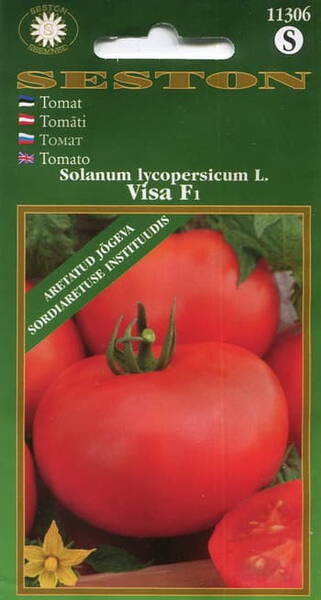Ex Tax: 1.55€
Indeterminate hybrid, early yield (from emergence to beginning of ripening 105–115 days).
The cluster is simple, compact. Each cluster has 7–9 flat-round, bright red fruits. Average fruit weight 95–100 g. Grown in spring greenhouses. Tolerates transportation well.
In 1 gram 350–500 seeds
* How to accelerate tomato ripening?
Our summer is short and not always hot, so tomatoes often do not ripen in the garden. But if you do not leave it to chance and use a few simple techniques, you can harvest earlier. And more.
In open ground.
To speed up ripening, spray the plants with an iodine solution (40 drops per 10 L of water per 1.5 m² bed).
Stop watering and fertilizing.
Carefully turn the branches of low-growing plants towards the sun, securing them with supports; place slings under the clusters.
Collect large brown and green tomatoes and place them to ripen.
Pinch the tops of the plants. Above inflorescences with already set tomatoes, leave two–three leaves – they will ensure fruit growth.
Lower leaves should be removed up to those clusters where tomatoes are already ripening. On low and medium-height bushes, leave a maximum of four–five clusters, so all extra flower clusters must be removed. After these operations, bushes will focus energy on fruit filling instead of growth.
When fruits have filled, perform one of the operations that limit water and nutrient flow from the roots: make longitudinal through-cuts in stems at a height of 8–12 cm, 7–10 cm long, insert splints so the gaps do not close, gently lift the plant several times while twisting it along the stem, tie the stem at 3–4 cm height with thin copper wire.
In the greenhouse.
The same manipulations are done a bit later with greenhouse tomatoes. If the greenhouse is unheated, leave 6–7 clusters per plant; in heated ones, 10–12 clusters.
Before frost, fruits on middle clusters will ripen completely, on upper clusters – partially. Remove emerging side shoots. Gradually maintain the number of leaves at 13–18.
Ripening: collect large green and brown fruits in the morning, before they warm up in the sun, and place them in a dry, ventilated room. In light, they ripen faster; in darkness – more evenly.
* If tomatoes should ripen slowly, select fruits of the same ripeness, place them in two–three layers, sprinkled with sawdust, and store at +8–10°C.
Tomatoes are harvested selectively, as they ripen. Those intended for immediate consumption are picked ripe, and those to be stored for a while – yellow-brown. Do not wait until they overripe – fruit quality decreases.
Do not rush to remove red tomatoes from a box of ripening fruits, as they accelerate the ripening of the entire harvest. Ripe fruits release ethylene gas, which accelerates ripening of the remaining fruits. If there are no ripe tomatoes, apples or other ripe fruits can be placed. Also, cover the boxes to prevent the gas from escaping.
Do you know why you can not store tomatoes in the refrigerator?..
Because at temperatures below +15 degrees, the tomato begins to lose its aroma, and the pulp of the fruit becomes loose and tasteless.












